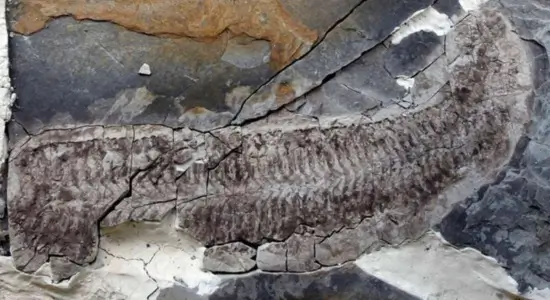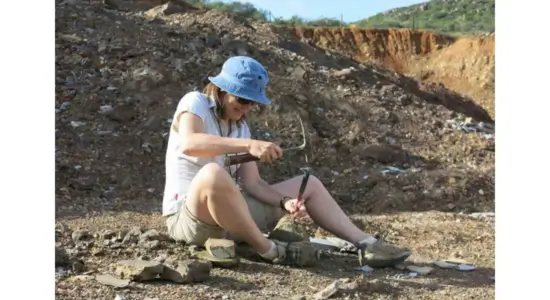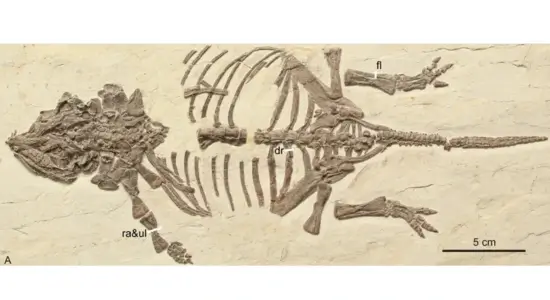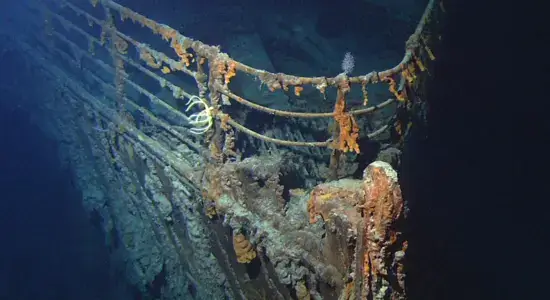Ancient Fossil ‘Sue’ Reveals a Stunning Inside-Out Secret
Imagine stumbling upon a fossil so bizarre that it flips everything we know about fossilization inside out—literally! That’s exactly what happened when paleontologists discovered a 444-million-year-old specimen with its soft insides perfectly preserved, but its outer shell completely gone. And guess what? They affectionately named it “Sue” after the lead researcher’s mom. ????✨

This incredible find is the result of 25 years of work by Professor Sarah Gabbott from the University of Leicester. Published in the journal Palaeontology, the study introduces a brand-new species: Keurbos susanae.
“Sue is an inside-out, legless, headless wonder,” Professor Gabbott says. “Her insides are a mineralized time capsule—muscles, sinews, tendons, and even her guts are preserved in unimaginable detail. But her tough outer shell, legs, and head? Completely gone, lost to time over 440 million years.”
Scientists are certain that Sue was a primitive marine arthropod, a group that includes today’s shrimp, lobsters, spiders, and centipedes. Normally, when arthropods fossilize, their outer shells survive, while their soft tissues decay. But Sue? She’s the total opposite! Her insides are intact, but her exterior vanished.

A Fossil from a Lost World
Sue was unearthed in Soom Shale, a sedimentary layer 250 miles north of Cape Town, South Africa. This region was once a deep-sea basin, home to an ancient marine ecosystem that somehow survived one of Earth’s biggest extinction events—the Ordovician glaciation, which wiped out 85% of all species. ❄️????
But here’s where it gets even weirder: The conditions in which Sue fossilized were downright toxic. The water was completely devoid of oxygen and loaded with deadly hydrogen sulfide (yep, the same stuff that makes rotten eggs stink ????). Scientists believe some kind of chemical magic must have taken place, preserving Sue’s soft tissues while the rest of her decayed away.
A Mystery That May Never Be Solved
As exciting as Sue is, her unique preservation presents a problem—without her outer features, it’s difficult to compare her to other fossils. That means scientists still don’t know exactly where she fits in the evolutionary tree.
Adding to the challenge, the quarry where Professor Gabbott found Sue 25 years ago is now almost gone, making the chances of finding another specimen incredibly slim. She had always hoped to discover another Sue—one with a head or legs intact—but after decades of searching, it seems this fossil is one-of-a-kind.

Stories about interesting discoveries
- Fossil of the “Flying Dragon of the Desert” Discovered – A Creature That Lived 160 Million Years Ago
- Mysterious Hoard of 800 Iron Age Artifacts Found Burned and Buried in a UK Field
A Special Name for a Special Fossil
For Professor Gabbott, naming Sue was deeply personal. “This research has been an ultramarathon—Sue is so well-preserved that there’s just so much anatomy to interpret,” she explains.
But the real push to name Sue came from her mom. “She recently told me, ‘Sarah, if you’re going to name that fossil after me, you’d better do it before I end up in the ground and fossilized myself!’ ????”
Professor Gabbott jokes that she named the fossil after her mom because she’s “a well-preserved specimen.” But in truth, it’s a tribute to her mother’s unwavering support. “She always told me to follow a career that made me happy, and for me, that’s digging up rocks, finding fossils, and uncovering the secrets of ancient life on Earth.”
And thanks to Sue, we now have one more mind-blowing piece of Earth’s ancient puzzle. ????????????
ref : phys






